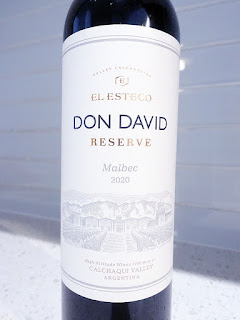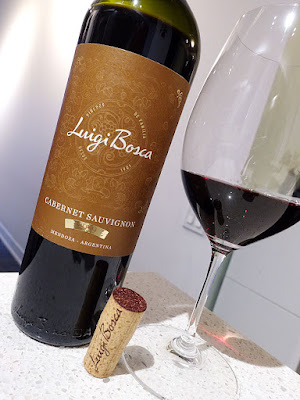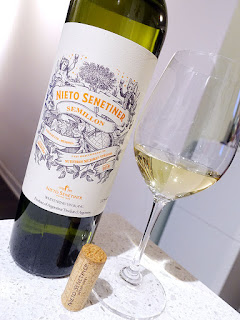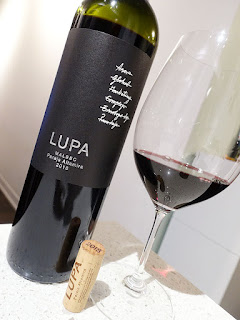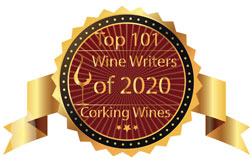I enjoyed the lovely 2018 Trapiche Medalla Malbec last year, and for wine review I uncorked it's companion wine - a Cabernet Sauvignon - that arrived at the LCBO last weekend as part of the LCBO VINTAGES Release.
It is produced by Trapiche Winery, Argentina's largest producer of wine. Established in 1883, Trapiche has grown to become one of Argentina's most internationally recognized brands. With a long history in exploration, Trapiche is also one of the wine industry's leading innovators while pioneering new sites, partnering with premium grape growers, and developing a new generation of talented winemakers. Some of Trapiche's pioneering efforts include being among the first in Argentina to work with Bordeaux varieties such as Cabernet Sauvignon, using French oak barrels, exploring micro-terroirs, and developing modern winemaking techniques.
Today, Trapiche owns more than 1,000 hectares of vineyards across Mendoza's Primera Zone and Uco Valley, as well as having longstanding partnerships with some of the province's revered grape growers. With a relentless determination to achieve the highest standards in the world of winemaking, Trapiche has received global recognition from publications such as Wine Enthusiast and Drinks International and won awards such as "The New World Winery of the Year" and "50 Most Admired Wine Brands".
Like the Malbec, this wine is part of Trapiche's Medalla collection of wines that was created in 1983 to celebrate the company's 100th anniversary. Each wine in the Medalla range is crafted using grapes from Mendoza's Primera Zona, the province's premium winemaking area, and predominantly old vineyards that have for decades produced the most prestigious Argentine wines. Medalla wines are 100% single varietal wines crafted with a nod to Old World style and sophistication. This particular wine is crafted with 100% Cabernet Sauvignon that was sourced from their vineyards in Luján de Cuyo. It was aged for 18 months in new French oak barrels.
The 2019 vintage in Argentina was excellent, with some winemakers calling it their best vintage of the decade. The hot, dry summer, particularly in Mendoza, was bookended by a cold winter, and cool spring and autumn, which slowed down ripening times (and moderating alcohol levels along with it), and brought harvest times in line with the average. Because of the cooler climate, yields were slightly lower than normal, but also resulted in highly concentrated wines with great colour and acidity. Let's see how this Cabernet Sauvignon from Argentina is tasting tonight...
100% Cabernet Sauvignon from Luján de Cuyo, this has fragrant, open, and intense aromatics offering lovely notes of ripe dark black-blue berry, dark currant, black cherry, cassis, plum, fine wood spices, and a touch of herb. It's full-bodied with ripe, chewy tannins and ripe black-blue fruit, currant, plum, and black cherry flavours balanced with savoury wood spice and earthy mineral. It has fresh, juicy acidity, while the dusty, fine-grained tannins provide a pleasing, lightly textured mouthfeel. Lovely earthy mineral notes linger on the long, savoury, and well-balanced finish. Highly recommended buy! Score: 90 pts
You can find many other lovely wines by Trapiche at the LCBO or through their Agent - Dandurand.
It is produced by Trapiche Winery, Argentina's largest producer of wine. Established in 1883, Trapiche has grown to become one of Argentina's most internationally recognized brands. With a long history in exploration, Trapiche is also one of the wine industry's leading innovators while pioneering new sites, partnering with premium grape growers, and developing a new generation of talented winemakers. Some of Trapiche's pioneering efforts include being among the first in Argentina to work with Bordeaux varieties such as Cabernet Sauvignon, using French oak barrels, exploring micro-terroirs, and developing modern winemaking techniques.
Today, Trapiche owns more than 1,000 hectares of vineyards across Mendoza's Primera Zone and Uco Valley, as well as having longstanding partnerships with some of the province's revered grape growers. With a relentless determination to achieve the highest standards in the world of winemaking, Trapiche has received global recognition from publications such as Wine Enthusiast and Drinks International and won awards such as "The New World Winery of the Year" and "50 Most Admired Wine Brands".
Like the Malbec, this wine is part of Trapiche's Medalla collection of wines that was created in 1983 to celebrate the company's 100th anniversary. Each wine in the Medalla range is crafted using grapes from Mendoza's Primera Zona, the province's premium winemaking area, and predominantly old vineyards that have for decades produced the most prestigious Argentine wines. Medalla wines are 100% single varietal wines crafted with a nod to Old World style and sophistication. This particular wine is crafted with 100% Cabernet Sauvignon that was sourced from their vineyards in Luján de Cuyo. It was aged for 18 months in new French oak barrels.
The 2019 vintage in Argentina was excellent, with some winemakers calling it their best vintage of the decade. The hot, dry summer, particularly in Mendoza, was bookended by a cold winter, and cool spring and autumn, which slowed down ripening times (and moderating alcohol levels along with it), and brought harvest times in line with the average. Because of the cooler climate, yields were slightly lower than normal, but also resulted in highly concentrated wines with great colour and acidity. Let's see how this Cabernet Sauvignon from Argentina is tasting tonight...
Tasting Note:
TRAPICHE MEDALLA CABERNET SAUVIGNON 2019 - Mendoza, Argentina (#568865) (XD) - $19.95100% Cabernet Sauvignon from Luján de Cuyo, this has fragrant, open, and intense aromatics offering lovely notes of ripe dark black-blue berry, dark currant, black cherry, cassis, plum, fine wood spices, and a touch of herb. It's full-bodied with ripe, chewy tannins and ripe black-blue fruit, currant, plum, and black cherry flavours balanced with savoury wood spice and earthy mineral. It has fresh, juicy acidity, while the dusty, fine-grained tannins provide a pleasing, lightly textured mouthfeel. Lovely earthy mineral notes linger on the long, savoury, and well-balanced finish. Highly recommended buy! Score: 90 pts
You can find many other lovely wines by Trapiche at the LCBO or through their Agent - Dandurand.









